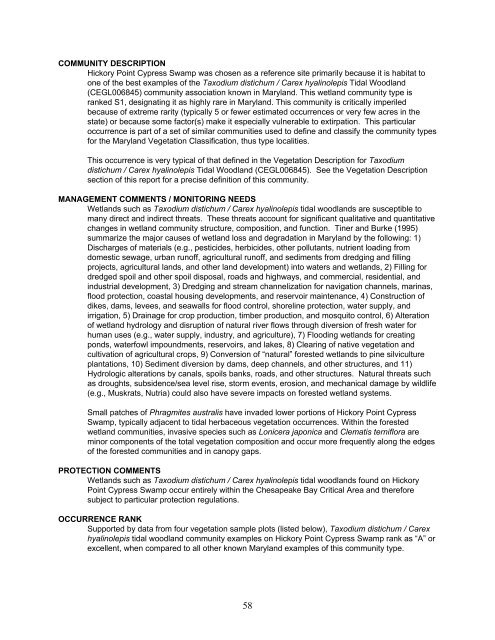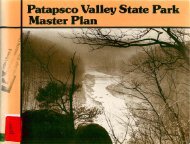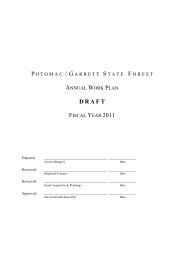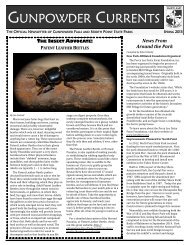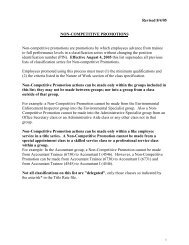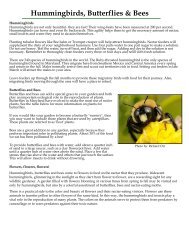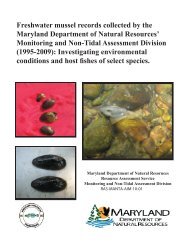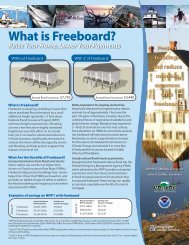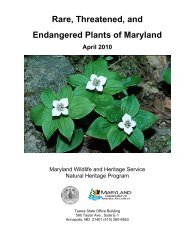tidal hardwood swamps - Maryland Department of Natural Resources
tidal hardwood swamps - Maryland Department of Natural Resources
tidal hardwood swamps - Maryland Department of Natural Resources
You also want an ePaper? Increase the reach of your titles
YUMPU automatically turns print PDFs into web optimized ePapers that Google loves.
COMMUNITY DESCRIPTION<br />
Hickory Point Cypress Swamp was chosen as a reference site primarily because it is habitat to<br />
one <strong>of</strong> the best examples <strong>of</strong> the Taxodium distichum / Carex hyalinolepis Tidal Woodland<br />
(CEGL006845) community association known in <strong>Maryland</strong>. This wetland community type is<br />
ranked S1, designating it as highly rare in <strong>Maryland</strong>. This community is critically imperiled<br />
because <strong>of</strong> extreme rarity (typically 5 or fewer estimated occurrences or very few acres in the<br />
state) or because some factor(s) make it especially vulnerable to extirpation. This particular<br />
occurrence is part <strong>of</strong> a set <strong>of</strong> similar communities used to define and classify the community types<br />
for the <strong>Maryland</strong> Vegetation Classification, thus type localities.<br />
This occurrence is very typical <strong>of</strong> that defined in the Vegetation Description for Taxodium<br />
distichum / Carex hyalinolepis Tidal Woodland (CEGL006845). See the Vegetation Description<br />
section <strong>of</strong> this report for a precise definition <strong>of</strong> this community.<br />
MANAGEMENT COMMENTS / MONITORING NEEDS<br />
Wetlands such as Taxodium distichum / Carex hyalinolepis <strong>tidal</strong> woodlands are susceptible to<br />
many direct and indirect threats. These threats account for significant qualitative and quantitative<br />
changes in wetland community structure, composition, and function. Tiner and Burke (1995)<br />
summarize the major causes <strong>of</strong> wetland loss and degradation in <strong>Maryland</strong> by the following: 1)<br />
Discharges <strong>of</strong> materials (e.g., pesticides, herbicides, other pollutants, nutrient loading from<br />
domestic sewage, urban run<strong>of</strong>f, agricultural run<strong>of</strong>f, and sediments from dredging and filling<br />
projects, agricultural lands, and other land development) into waters and wetlands, 2) Filling for<br />
dredged spoil and other spoil disposal, roads and highways, and commercial, residential, and<br />
industrial development, 3) Dredging and stream channelization for navigation channels, marinas,<br />
flood protection, coastal housing developments, and reservoir maintenance, 4) Construction <strong>of</strong><br />
dikes, dams, levees, and seawalls for flood control, shoreline protection, water supply, and<br />
irrigation, 5) Drainage for crop production, timber production, and mosquito control, 6) Alteration<br />
<strong>of</strong> wetland hydrology and disruption <strong>of</strong> natural river flows through diversion <strong>of</strong> fresh water for<br />
human uses (e.g., water supply, industry, and agriculture), 7) Flooding wetlands for creating<br />
ponds, waterfowl impoundments, reservoirs, and lakes, 8) Clearing <strong>of</strong> native vegetation and<br />
cultivation <strong>of</strong> agricultural crops, 9) Conversion <strong>of</strong> “natural” forested wetlands to pine silviculture<br />
plantations, 10) Sediment diversion by dams, deep channels, and other structures, and 11)<br />
Hydrologic alterations by canals, spoils banks, roads, and other structures. <strong>Natural</strong> threats such<br />
as droughts, subsidence/sea level rise, storm events, erosion, and mechanical damage by wildlife<br />
(e.g., Muskrats, Nutria) could also have severe impacts on forested wetland systems.<br />
Small patches <strong>of</strong> Phragmites australis have invaded lower portions <strong>of</strong> Hickory Point Cypress<br />
Swamp, typically adjacent to <strong>tidal</strong> herbaceous vegetation occurrences. Within the forested<br />
wetland communities, invasive species such as Lonicera japonica and Clematis terniflora are<br />
minor components <strong>of</strong> the total vegetation composition and occur more frequently along the edges<br />
<strong>of</strong> the forested communities and in canopy gaps.<br />
PROTECTION COMMENTS<br />
Wetlands such as Taxodium distichum / Carex hyalinolepis <strong>tidal</strong> woodlands found on Hickory<br />
Point Cypress Swamp occur entirely within the Chesapeake Bay Critical Area and therefore<br />
subject to particular protection regulations.<br />
OCCURRENCE RANK<br />
Supported by data from four vegetation sample plots (listed below), Taxodium distichum / Carex<br />
hyalinolepis <strong>tidal</strong> woodland community examples on Hickory Point Cypress Swamp rank as “A” or<br />
excellent, when compared to all other known <strong>Maryland</strong> examples <strong>of</strong> this community type.<br />
58


